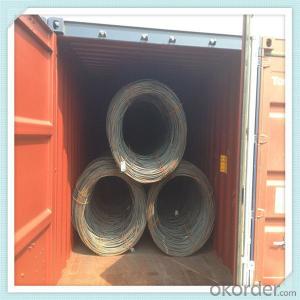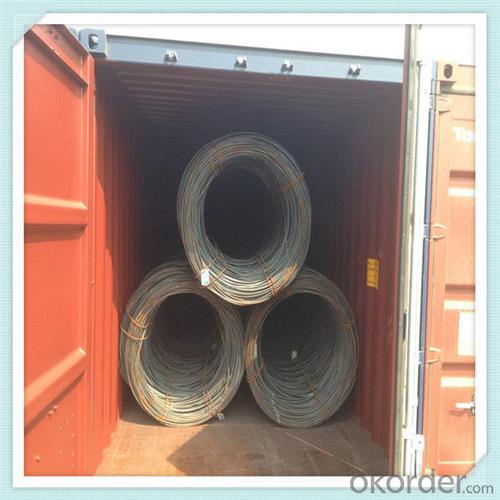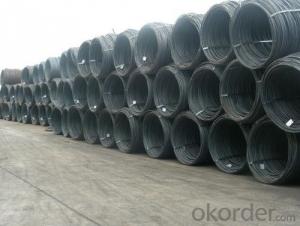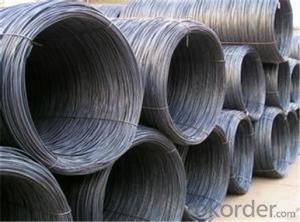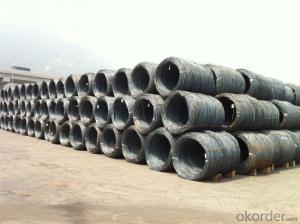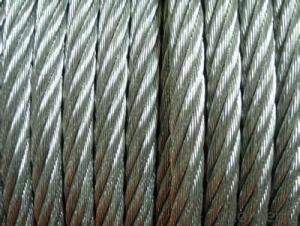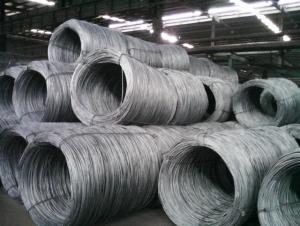SAE1006 Steel wire rod 5.5mm-14mm hot sale
- Loading Port:
- Tianjin
- Payment Terms:
- TT OR LC
- Min Order Qty:
- 100 m.t.
- Supply Capability:
- 13526 m.t./month
OKorder Service Pledge
OKorder Financial Service
You Might Also Like
Specification
Wire rod is a rolled alloy or nonalloy steel product, produced from a semi (e.g. bloom) and having a round,
rectangular or other cross-section. Particularly fine cross-sections may be achieved by subsequent cold
forming (drawing). Wire rod is wound into coils and transported in this form.
Features
1、Pure steel quality, stable chemical contents, small tolerance.
2、Constant Quality, good drawing performance.
3、High dimension accuracy degree, accuracy degree of Level C up to 80%, smooth surface, less scale,
easy to be pickled.
4、Automatic bundling with 4 lines by Machine in tidy and good looks
5、Big high quality percentage, small coil percentage, and heavy coil weight for Hard Coil.
6、High sorbitizing percentage.
Product Description :
Standard | AISI, ASTM, BS, DIN, GB, JIS |
Material/steel grade | Q195-Q235,SAE1006B,SAE1006CR, SAE1008B, SAE1008CR, SAE1010B, SAE1018B, or according to customers requirements |
Wire Gauge | 5.5-12mm |
Coil weight | 1.8-2.1mts |
MOQ | 25MT |
Delivery Time | 15-30 days after receipt of L/C or deposit by T/T |
Packing | In coil and load in container, if large quantity, by bulk vessel; Can be packed as customers' special requirements |
Payment terms | 1).100% irrevocable L/C at sight. 2).30% T/T prepaid and the balance against the copy of B/L. 3).30% T/T prepaid and the balance against L/C |
Application | widely used in machinery parts, manufacturing industry, electronics industry, metal tools and others |

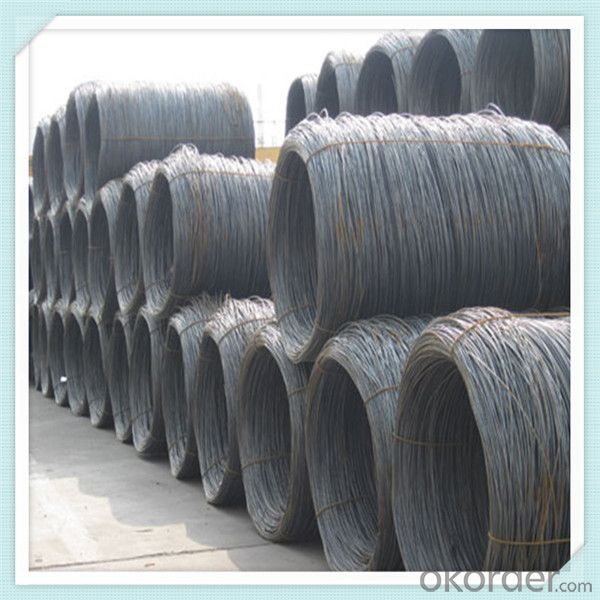
Application :
It generally used in braiding the hose for bathing product and machinery. With it
good flexibility, resistant to high temperature and resistant to corrosion, it
used widely in many industries.
Packing :
Hot-rolled wire rod is held in a unit with at least four steel straps in the
transverse direction and transported and stored without further packaging.
Before
the steel strapping is applied, the wire rod must be sufficiently compressed.
The strapping is fixed in the transverse direction with a single circumferential
strap so that the strapping does not slip and cause the coil to come apart.
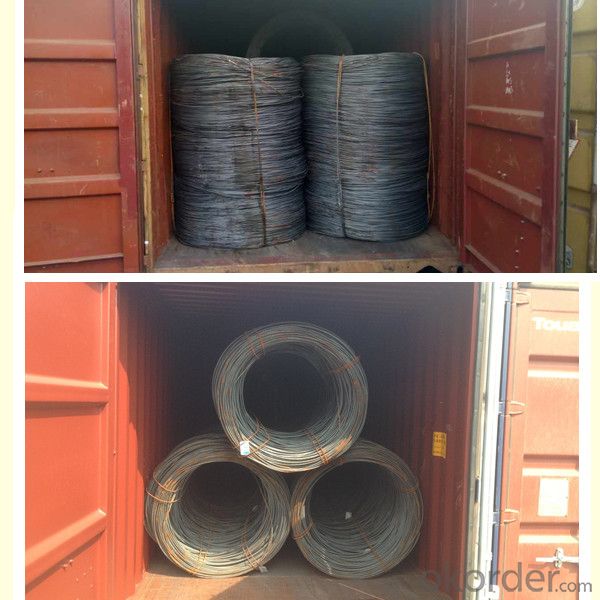
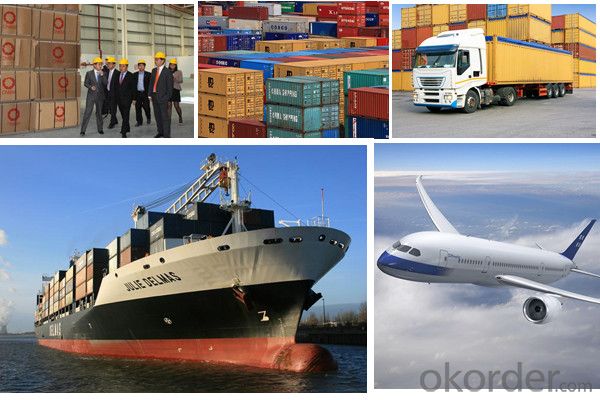
Our service:
(1) We cooperate with famous factories with advanced equipment and well trained workers.
(2) We can provide factory price with trading company service.
(3) We continuously work on the improvement of our processes, guaranteeing
consistently high standards of quality to keep none compensation.
(4) We guarantee 24 hours response and 48 hours solution providing service.
(5) We accept small order quantity before formal cooperation.
(6) We deliver the agreed quality at the agreed time, reacting to changes in
customer wishes in a flexible way.
(7) Due to our volume and selling power, we have excellent freight rates with
shipping lines.
(8) We strive to always be fair and honest in our dealings with customers.
(9) We strive to work together with customers to achieve much more than we can
achieve alone.
(10) Through our passion and commitment we aim to be a market leader in all our
key markets. To maintain our position as market leader we must continue to add
value in all that we do.
FAQ:
1.Q: What's your MOQ(minimum order quantity)?
A: One full container, mixed acceptable .
2. Q: What's your packing methods?
A: Packed in bundle or bulk ..
3. Q: How can I buy CNBM products in my country?
A:Please send us an inquiry or email ,we will reply to you if there is distributor in your country
4. Q: Can we visit your factory?
A: Warmly welcome. Once we have your schedule, we will arrange the
professional sales team to follow up your case.
5. Q: How long does it take to get the product if i place an order?
A:With the process of your requirements,we will pack and deliver in 3
-7 days. If it is by sea shipment,it will take 15-45 days depending on different locations
- Q: What are the different types of steel wire rod surface cleaning methods for wire galvanizing?
- Wire galvanizing requires the use of various steel wire rod surface cleaning methods to eliminate impurities and contaminants. These methods are specifically designed to prepare the wire rod for the galvanizing process. One commonly used technique is acid pickling, which involves immersing the wire rod in a bath containing hydrochloric acid or sulfuric acid. The acid effectively dissolves mill scale, rust, and other contaminants, leaving the wire rod clean and ready for galvanizing. Another method, mechanical descaling, employs mechanical means such as abrasive brushes or shot blasting to physically eliminate surface impurities. This method is ideal for wire rods with heavy scale or stubborn contaminants that cannot be easily removed through acid pickling alone. Additionally, there is the electrolytic cleaning method, which utilizes an electric current to eliminate surface impurities. The wire rod is submerged in an electrolyte solution, and the electric current causes the impurities to migrate away from the wire rod towards the opposite electrode. This method is typically employed for wire rods with a thin layer of oxide or other surface contaminants. Lastly, mechanical cleaning involves using mechanical means like wire brushing or sanding to scrub the wire rod's surface and eliminate any impurities. This method is suitable for wire rods with light scale or surface contaminants that can be easily removed through mechanical means. Ultimately, the selection of a cleaning method depends on the specific requirements and condition of the wire rod. Each method has its own advantages and disadvantages in terms of effectiveness, cost, and environmental impact.
- Q: How is steel wire rod used in the production of wire products?
- Wire products rely heavily on steel wire rod as a vital component in their production. This semi-finished product is created through a rolling process from steel billets. It is widely used across different industries as a raw material to manufacture various types of wire products. The production of steel wires is one of the primary uses for steel wire rod. These wires find extensive applications in construction, automotive, electrical, and manufacturing sectors for diverse purposes. For instance, they are employed in reinforcing concrete structures, creating wire ropes, making fences, springs, nails, and screws. To manufacture wire products, steel wire rod undergoes a series of manufacturing processes. Initially, it is heated and then passed through rolling mills to decrease its diameter and increase its length. This process, referred to as hot rolling, enhances the mechanical properties of the wire rod. Following hot rolling, the wire rod is cooled and subjected to a pickling process to eliminate any scale or impurities from its surface. It is then drawn through dies to further reduce its diameter and improve its surface finish. This cold drawing process enhances the wire's strength and ductility. Once the desired size and properties are achieved, the wire can be further processed or supplied as a finished product. Depending on the requirements, additional processes such as heat treatment, coating, or surface finishing may be applied to enhance the wire's performance and make it suitable for specific applications. In conclusion, steel wire rod plays a critical role as a raw material in the production of wire products. Its versatility, strength, and ductility make it an optimal choice for a wide range of applications. Through various manufacturing processes, the wire rod is transformed into high-quality steel wires that find extensive use in construction, automotive, electrical, and manufacturing industries.
- Q: What are the main factors affecting the market competition of steel wire rod?
- The main factors affecting the market competition of steel wire rod include the availability and cost of raw materials such as iron ore and scrap metal, the level of demand and consumption in various industries such as construction and automotive, technological advancements in production processes, government regulations and policies, competition from substitute materials, and the overall economic conditions and global trade dynamics. Additionally, factors like pricing strategies, product quality, and customer relationships also play a significant role in determining the level of competition in the steel wire rod market.
- Q: How is steel wire rod used in the manufacturing of wire mesh cages?
- Steel wire rod is used in the manufacturing of wire mesh cages as it provides high tensile strength and durability. The wire rod is first drawn through a series of dies to reduce its diameter and increase its length. This process creates a thin and flexible wire that is then woven or welded together to form the wire mesh cage. The steel wire rod ensures that the wire mesh cages can withstand heavy loads, resist corrosion, and maintain their shape, making them suitable for various applications such as storage, security, and animal containment.
- Q: What are the main factors affecting the market customer service of steel wire rod?
- There are several main factors that can affect the market customer service of steel wire rod. Firstly, the quality and consistency of the product itself play a significant role. Customers expect steel wire rod to meet certain standards in terms of strength, durability, and reliability. Any deviation from these expectations can lead to dissatisfaction and loss of trust. Secondly, timely and efficient delivery is crucial in customer service. Steel wire rod is often used in time-sensitive projects, and delays in shipment can result in costly disruptions. Therefore, reliable logistics and on-time delivery are essential to maintain good customer relationships. Another important factor is customer support and responsiveness. Promptly addressing customer inquiries, concerns, and complaints can significantly impact customer satisfaction. Providing knowledgeable and helpful support can enhance the overall customer experience. Additionally, pricing and competitiveness in the market also affect customer service. If suppliers offer competitive prices and terms, it can attract more customers and foster long-term relationships. Clear and transparent pricing policies can also contribute to a positive customer experience. Ultimately, the main factors affecting the market customer service of steel wire rod revolve around product quality, delivery reliability, customer support, and competitive pricing. By focusing on these aspects, companies can strive to meet customer expectations and build strong relationships in the market.
- Q: How is steel wire rod used in the manufacturing of wire forms for jewelry?
- Steel wire rod is a primary raw material used in the manufacturing of wire forms for jewelry. It serves as the base material from which various wire forms such as chains, clasps, and pendants are created. The steel wire rod is typically processed through a series of manufacturing techniques, including drawing and annealing, which help to shape and strengthen the wire. Once the wire forms are created, they can be further embellished with beads, gemstones, or other decorative elements to create intricate and unique jewelry pieces.
- Q: What are the different types of steel wire rod surface finishes after wire drawing?
- After wire drawing, there are several different types of steel wire rod surface finishes that can be achieved. These finishes are often used to enhance the appearance and performance of the wire, as well as to protect it from corrosion and other environmental factors. Some of the most common types of steel wire rod surface finishes include: 1. Bright finish: This is the most basic type of finish, where the wire is left in its natural state after wire drawing. It has a shiny, reflective surface and is often used for applications where aesthetics are not a major concern. 2. Galvanized finish: In this finish, the wire is coated with a layer of zinc to protect it from corrosion. Galvanized wire has a dull, matte appearance and is commonly used in outdoor applications where the wire will be exposed to moisture and other harsh conditions. 3. Phosphated finish: Phosphating is a chemical process where the wire is treated with a phosphate coating to improve its corrosion resistance and adhesion properties. This finish is often used in applications where the wire will be subjected to high temperatures or corrosive environments. 4. Coated finish: In this finish, the wire is coated with a layer of polymer or other protective material. Coated wire has a smooth, uniform surface and is commonly used in applications where the wire needs to be insulated or protected from abrasion. 5. Nickel-plated finish: In this finish, the wire is coated with a layer of nickel to enhance its corrosion resistance and improve its appearance. Nickel-plated wire has a bright, shiny surface and is often used in decorative applications or in environments where the wire will be exposed to moisture and corrosive substances. These are just a few examples of the different types of steel wire rod surface finishes that can be achieved after wire drawing. The choice of finish will depend on the specific requirements of the application and the desired properties of the wire.
- Q: How is steel wire rod used in the production of wire mesh for erosion control?
- Steel wire rod is used in the production of wire mesh for erosion control as it serves as the primary material for creating the mesh structure. The steel wire rod is first processed and shaped into thin, continuous wires. These wires are then woven or welded together to form a mesh pattern, which provides strength, stability, and durability to the wire mesh. This mesh is crucial in preventing soil erosion by acting as a barrier and retaining the soil in place, thereby protecting slopes, embankments, and other vulnerable areas from erosion caused by water or wind.
- Q: How is steel wire rod used in the manufacturing of wire rope assemblies for lifting equipment?
- Steel wire rod plays a vital role in the production of wire rope assemblies for lifting equipment. To enhance its strength, durability, and resistance to corrosion, the wire rod undergoes a series of mechanical operations, including drawing, annealing, and coating. Once prepared, the wire rod is transformed into individual wires using a stranding process. These wires are then twisted together to form strands, which are further twisted in a helical pattern around a core to create the wire rope. The specific requirements of the lifting equipment determine the number of strands and the direction of twisting. The utilization of steel wire rod in wire rope assemblies guarantees the necessary strength and load-bearing capacity for lifting heavy objects. Steel wire possesses exceptional tensile strength, enabling it to withstand high loads and maintain structural integrity even in extreme conditions. Additionally, the flexibility and malleability of steel wire make it easily adaptable to various shapes and configurations, making it suitable for diverse lifting applications. Wire rope assemblies crafted from steel wire rod find extensive use across industries such as construction, mining, oil and gas, and manufacturing. They are commonly employed in cranes, elevators, hoists, winches, and other lifting equipment to move heavy loads safely and efficiently. The reliable and robust nature of wire rope assemblies ensures the safety of workers and the integrity of the equipment, establishing them as an integral component in the lifting industry.
- Q: What are the different annealing processes used for steel wire rod?
- The different annealing processes used for steel wire rod include full annealing, spheroidization annealing, and process annealing. Full annealing involves heating the wire rod to a temperature above its critical temperature and then slowly cooling it to room temperature to soften it and improve its ductility. Spheroidization annealing is a type of full annealing that is specifically used for high carbon steel wire rod to transform its brittle cementite structure into spherical carbides, enhancing its machinability and reducing the risk of breakage. Process annealing, on the other hand, is a partial annealing process that is performed on cold-worked wire rod to relieve internal stresses and restore some of its ductility without affecting its mechanical properties.
Send your message to us
SAE1006 Steel wire rod 5.5mm-14mm hot sale
- Loading Port:
- Tianjin
- Payment Terms:
- TT OR LC
- Min Order Qty:
- 100 m.t.
- Supply Capability:
- 13526 m.t./month
OKorder Service Pledge
OKorder Financial Service
Similar products
Hot products
Hot Searches
Related keywords
